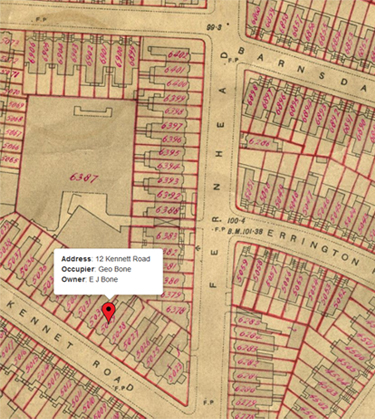
Discover Your Ancestors
Two critically acclaimed publications are available to family history researchers - the annual print magazine, Discover Your Ancestors, and the monthly online magazine, Discover Your Ancestors Periodical. Click here to subscribe.TheGenealogist begins major release of 1910 Domesday Survey

George Bone, a coroner’s officer lived at 12 Kennett Road in 1910. The area has now been redeveloped and the road name reused further north in a new realigned thoroughfare
TheGenealogist is releasing the first part of an exciting new record set; The Lloyd George Domesday Survey – a major new release that will reveal where an ancestor lived in 1910. This unique combination of maps and residential data, held by The National Archives, can precisely locate your ancestor’s house on large scale (five feet to the mile), hand-annotated maps of London that plot the exact property.
Researchers often can’t find where ancestors lived as road names change over time, the Blitz bombing areas to destruction, developers changing sites out of all resemblance from what had stood there before, lanes and roads extinguished to build estates and office blocks. All this means that searching for where an ancestor lived using a website linked to modern maps can be frustrating when they fail to pinpoint where the old properties had once been.
Researchers often can’t find where ancestors lived as road names change over time, the Blitz bombing areas to destruction, developers changing sites out of all resemblance from what had stood there before, lanes and roads extinguished to build estates and office blocks. All this means that searching for where an ancestor lived using a website linked to modern maps can be frustrating when they fail to pinpoint where the old properties had once been.
TheGenealogist’s new release will link individual properties to extremely detailed Ordnance Survey maps used in 1910
- Locate an address found in a census or street directory down to a specific house.
- Fully searchable by name, county, parish and street.
- The maps will zoom down to show the individual properties as they existed in 1910.
Complementing the maps on TheGenealogist are the accompanying books that will also provide researchers with basic information relative to the valuation of each property, including the valuation assessment number, map reference, owner, occupier, situation, description and extent.
The programme begins with the first release of the IR91 Index with subsequent releases of the more detailed IR58 Field books planned.
The mammoth project has over 94,500 Field Books each having hundreds of pages to digitise with associated large scale IR121 annotated OS maps.
The initial release from TheGenealogist is for the City of London and Paddington maps with their index records. Future releases will expand out across the country with cross linked maps wherever they are available.
Mark Bayley, Head of Development at TheGenealogist said: ‘With our English & Welsh Tithe Map collection, we’ve become known for our map based records and this new collection makes a fantastic later addition. The maps show an incredible amount of detail, allowing you to zoom right in on the hand annotated property. The records that go with these maps are just as detailed, allowing you to find out all manner of information about your ancestral home.’
The National Archives issued the following statement: ‘The Lloyd George ‘Domesday Records’ form essentially a census of property for Edwardian England and Wales. The innovative linking of individually searchable property data with associated annotated Ordnance Survey maps will be of huge value to family and local historians alike.’
Find out more and watch a useful introductory video at: TheGenealogist.co.uk/1910Survey/.